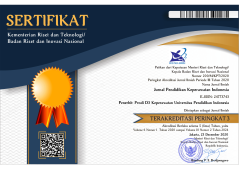HUBUNGAN MOTIVASI BERPRESTASI DENGAN ADVERSITY QUOTIENT WARGA BINAAN REMAJA DI LPKA KELAS II SUKAMISKIN BANDUNG
Abstract
ABSTRAK
Warga binaan remaja memiliki hambatan dan tentangan yang lebih besar dibandingkan dengan remaja normal lainnya. Mereka lebih beresiko mengalami gangguan psikologis selama di LPKA, oleh karena itu Adversity Quotient menjadi salah satu aspek yang penting dimiliki warga binaan remaja dalam menghadapi hambatan tersebut. AQ dipengaruhi oleh daya saing, produktivitas, kreativitas, motivasi, dan belajar. Motivasi merupakan aspek yang masih jarang diberikan kepada warga binaan remaja, sehingga penelitian ini bertujuan untuk melihat hubungan motivasi berprestasi dengan adversity quotient pada warga binaan remaja di LPKA kelas II Sukamiskin Bandung.Rancangan peneliti an ini menggunakan metode deskriptif korelatif dengan teknik pengambilan sampel menggunakan total sampling dengan jumlah sampel sebanyak 84 orang. Instrumen yang digunakan adalah Adversity response profile (ARP) quick take untuk mengukur adversity quotient dan instrumen motivasi berprestasi dengan rentang nilai validitas 0,316-0,751 dan nilai reabilitas 0,926 untuk mengukur motivasi berprestasi. Data dianalisis dengan menggunakan distribusi frekuensi untuk analisis univariat dan uji spearmen-rank untuk analisis bivariat. Hasil penelitian menunjukan bahwa 47 responden mempunyai motivasi berprestasi yang rendah ( 56% ) serta 52 (61,9%) responden mempunyai adversity quotient yang sedang. Analisis korelasi Spearmen – rank menunjukan bahwa adanya hubungan antara motivasi berprestasi dengan adversity quotient dengan nilai r = 0,724 dan p value = 0,00.Simpulan dari penelitian ini terdapat hubungan antara motivasi berprestasi dengan adversity quotient yang bersifat positif dengan tingkat keterikatan yang kuat dan signifikan.Pendekatan keperawatan melalui model ARCS serta dikolaborasikan dengan terapi kognitif merupakan intervensi keperawatan yang bisa digunakan dalam membantu meningkatkan motivasi berprestasi dan adversity quotient pada warga binaan remaja.
Kata kunci : adversity quotient, motivasi berprestasi, warga binaan remaja
ABSTRACT
Juvenile inmates have obstacles and challenges are greater than normal teenager, they are more at risk of psychological disorders during in LPKA. Adversity quotient is important aspect for juvenile inmates in period of custody. AQ affected by competitiveness, productivity, creativity, motivation, and learning process. Motivation is one of the aspects that still not adequately given to the adolescent in period of custody yet, so that the aim of this study is to see the relationship between achievement motivation and adversity quotient among juvenile inmates at LPKA class II Sukamiskin Bandung. The method that used in this study is descriptive correlative with total sampling technique and total respondent are 84 adolescent. This study used Adversity Response Profile (ARP) quick take to measure adversity quotient and achievement motivation instrument as the instrument with the range of validity between 0,316 – 0,751 and reliability value 0,926 to measure achievement motivation. Data were analyzed by frequency distribution to analyze univariate and spearman-rank test to analyze bivariate. Result of this study showed that 47 (56%) respondents have low achievement motivation and 42 (61,9%) respondents have moderate adversity quotien Spearmen-rank analysis showed that the relationship between achievement motivation and adversity quotient with r value = 0.724 and p value = 0.00.This study conclude that there is relation between achievement motivation and adversity quotient positively with strong and significant bond. Nursing approach by using ARCS model collaborated with cognitive therapy can be used as nursing intervention to increase achievement motivation and adversity quotient in adolescent in period of custody.
Keyword : adversity quotient, achievement motivation, juvenile inmates
Full Text:
PDFReferences
Cooke, D. J. (2002). Psychology In Prisons. British: Routledge .
Hurlock. (2003). Psikologi Perkembangan. Jakarta: Erlangga.
McClelland, D. (1987). Human Motivation. New York: University of Camridge.
McClelland, D. C., & Atkinson, J. W. (1953). The Achievement Motive. Michigan: the University of Michigan.Sarwono, S. W. (2013). Psikologi Remaja. Jakarta: Erlangga.
Pangma, Rachapoom.., Tayraukham, S. &Nuangchalerm, P. (2009). Causal Factors Influencing Adversity Quotient of Twelfth Grade and Third-Year Vocational Students. Journal of Social Sciences 5 (4): 466-470
Santrock, J. W. (2003). Adolescence: Perkembangan Remaja. Jakarta: Erlangga.
Santrock, J. W. (2007). Psikologi Pendidikan. Jakarta: Kencana.
Siaahan, E., Fitria, N., & Oktavia, N. (2012). Gambaran Faktor-Faktor yang Memengaruhi Adversity Quotient Warga Binaan Remaja di Rumah Tahanan Negara Klas 1 Bandung. Jurnal Universitas Padjadjaran, 1-15.
Stoltz. (2007). Adversity Quotient : Mengubah Hambatan Menjadi Peluang. Jakarta: Grasindo.
Stoltz, P. G., Thompson , J., & Beamen, R. (2009). Technical Overview for the AQ Profile : Reliability and Validity. Retrieved February 28, 2016, from Peaklearning: http://www.peaklearning.com/about_aq-profile_technical-data.php
WHO. (2016, February 23). Adolscent Development. Retrieved February 29, 2016, from Maternal, Newborn, Child, and Adolscent Health: http://www.who.int/maternal_child_adolescent/topics/adolescence/development/en/
DOI: https://doi.org/10.17509/jpki.v2i1.2853
Refbacks
- There are currently no refbacks.
Jurnal Pendidikan Keperawatan Indonesia(JPKI) published by Indonesia University of Education. JPKI is licensed under a Creative Commons Attribution-ShareAlike 4.0 International License.
Office :
Nursing Department. FPOK UPI.
229, Dr. Setiabudhi Street. Bandung 40154
West Java , Indonesia
E-mail : jpki@upi.edu

_.png)
_.png)
_.png)











